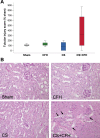Cell-free hemoglobin augments acute kidney injury during experimental sepsis
- PMID: 31364379
- PMCID: PMC6843044
- DOI: 10.1152/ajprenal.00375.2018
Cell-free hemoglobin augments acute kidney injury during experimental sepsis
Abstract
Acute kidney injury is a common complication of severe sepsis and contributes to high mortality. The molecular mechanisms of acute kidney injury during sepsis are not fully understood. Because hemoproteins, including myoglobin and hemoglobin, are known to mediate kidney injury during rhabdomyolysis, we hypothesized that cell-free hemoglobin (CFH) would exacerbate acute kidney injury during sepsis. Sepsis was induced in mice by intraperitoneal injection of cecal slurry (CS). To mimic elevated levels of CFH observed during human sepsis, mice also received a retroorbital injection of CFH or dextrose control. Four groups of mice were analyzed: sham treated (sham), CFH alone, CS alone, and CS + CFH. The addition of CFH to CS reduced 48-h survival compared with CS alone (67% vs. 97%, P = 0.001) and increased the severity of illness. After 24 and 48 h, CS + CFH mice had a reduced glomerular filtration rate from baseline, whereas sham, CFH, and CS mice maintained baseline glomerular filtration rate. Biomarkers of acute kidney injury, neutrophil gelatinase-associated lipocalin (NGAL) and kidney injury molecule-1 (KIM-1), were markedly elevated in CS+CFH compared with CS (8-fold for NGAL and 2.4-fold for KIM-1, P < 0.002 for each) after 48 h. Histological examination showed a trend toward increased tubular injury in CS + CFH-exposed kidneys compared with CS-exposed kidneys. However, there were similar levels of renal oxidative injury and apoptosis in the CS + CFH group compared with the CS group. Kidney levels of multiple proinflammatory cytokines were similar between CS and CS + CFH groups. Human renal tubule cells (HK-2) exposed to CFH demonstrated increased cytotoxicity. Together, these results show that CFH exacerbates acute kidney injury in a mouse model of experimental sepsis, potentially through increased renal tubular injury.
Keywords: acute kidney injury; cell-free hemoglobin; sepsis.
Conflict of interest statement
No conflicts of interest, financial or otherwise, are declared by the authors.
Figures







References
-
- Baek JH, D’Agnillo F, Vallelian F, Pereira CP, Williams MC, Jia Y, Schaer DJ, Buehler PW. Hemoglobin-driven pathophysiology is an in vivo consequence of the red blood cell storage lesion that can be attenuated in guinea pigs by haptoglobin therapy. J Clin Invest 122: 1444–1458, 2012. doi:10.1172/JCI59770. - DOI - PMC - PubMed
Publication types
MeSH terms
Substances
Grants and funding
LinkOut - more resources
Full Text Sources
Other Literature Sources
Medical
Miscellaneous

